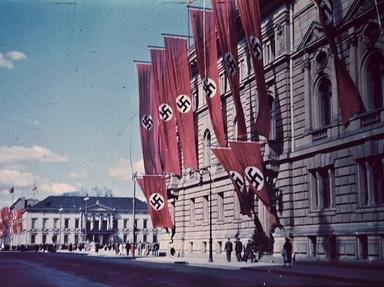Quiz Answer Key and Fun Facts
1. November 1923: Adolf Hitler and the Sturmabteilung (SA) interrupted a speech by the Minister President of Bavaria in what turned out to be a failed coup. What is the name commonly given to this event that resulted in Hitler's incarceration?
2. June 1925: Hitler created a group of personal bodyguards that would grow into a massive machine of hate and murder that operated in the infamous killing centres, the death camps. What was the name of this organisation that was under the administration of Heinrich Himmler?
3. July 1927: The propaganda machine, that would later become synonymous with Joseph Goebbels, intensified with the introduction of rally events in which German city?
4. January 1933: Adolf Hitler took a momentous step forward in lawfully gaining which high ranking role in the German political system?
5. February 1933: One of the great 'whodunits' of history unfolded in Germany. For many decades academic and amateur historians have debated, argued, pondered and hypothesised about who was behind one of the most famous arson attacks in European history. Part of which German structure was burnt down in this year?
6. March 1933: Hitler began implementing his plans very quickly and in particular advanced the issue of what to do with the 'racially impure'. This month saw the establishment of the first concentration camp. Which was it?
7. June 1934: The Sturmabteilung ('Brownshirts') were instrumental in Hitler's rise to power, however they were perceived to be an assembly of thugs by many Germans. Hitler thus decided they needed to be removed before they became a hindrance and what resulted was the purge of high ranking members of the organisation. What night is this known as?
8. March 1938: Nazi Germany's military forces were expanding and Hitler was ready to, in his opinion, right the wrongs of the Treaty of Versailles, by force. Hitler's aim was to bring all German-speaking people back into the fatherland. This first happened in March of 1938 in Austria. What was the annexation of Austria by Germany called?
9. September 1938: The Munich agreement was signed by European statesmen. This is often seen as the leading example of appeasement in the inter-war years as it allowed Germany to take the Sudetenland from the Czechs. Who was the British prime minister who signed the agreement?
10. September 1939: The Polish corridor became a significant area in world history. Adolf Hitler had previously expressed his desire to annex a particular city (that is now situated in Poland) and in September of 1939 he sent the military in thus inducing declarations of war from both France and Britain. What was this pivotal city?
Source: Author
jonnowales
This quiz was reviewed by FunTrivia editor
bloomsby before going online.
Any errors found in FunTrivia content are routinely corrected through our feedback system.

